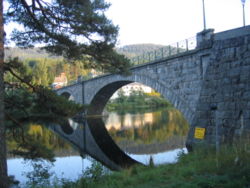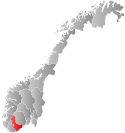| Revision as of 07:40, 14 November 2012 editEmausBot (talk | contribs)Bots, Template editors2,861,220 editsm r2.7.3) (Robot: Adding sq:Åmli← Previous edit | Revision as of 18:33, 17 November 2012 edit undoSnrRailways (talk | contribs)2,011 edits →GeographyNext edit → | ||
| Line 53: | Line 53: | ||
| The most densely populated area is around the administration center Åmli, which lies on the banks of the Nidelva. About 600 people lived in the administrative center in 1997. Side valleys which join the main valley include Gjøvdal and Tovdal. The rivers Nidelva and ] flow through the valleys. | The most densely populated area is around the administration center Åmli, which lies on the banks of the Nidelva. About 600 people lived in the administrative center in 1997. Side valleys which join the main valley include Gjøvdal and Tovdal. The rivers Nidelva and ] flow through the valleys. | ||
| In the south of the municipality the ] is at ]. The main settlement areas are ], Nelaug, ], and ]. The rest of the population is scattered among the valleys. | In the south of the municipality the ] is at ]. The main settlement areas are ], Nelaug, ], and ]. The rest of the population is scattered among the valleys. | ||
| The Åmli hills are wooded and typically range from {{convert|700|to|800|m}} above sea level. At {{convert|930|m}}, the highest point is Trongedalsfjell, which lies between Tovdal and Gjøvdal. Several lakes are located in Åmli including ], ], and ]. | The Åmli hills are wooded and typically range from {{convert|700|to|800|m}} above sea level. At {{convert|930|m}}, the highest point is Trongedalsfjell, which lies between Tovdal and Gjøvdal. Several lakes are located in Åmli including ], ], and ]. | ||
Revision as of 18:33, 17 November 2012
Municipality in Aust-Agder, Norway| Åmli Municipality Åmli kommune | |
|---|---|
| Municipality | |
 Nidelva river in Åmli Nidelva river in Åmli | |
 Flag Flag Coat of arms Coat of arms | |
 Aust-Agder within Norway Aust-Agder within Norway | |
 Åmli within Aust-Agder Åmli within Aust-Agder | |
| Country | Norway |
| County | Aust-Agder |
| District | Sørlandet |
| Administrative centre | Åmli |
| Government | |
| • Mayor (2003) | Tellef Olstad (Sp) |
| Area | |
| • Total | 1,130.60 km (436.53 sq mi) |
| • Land | 1,067.95 km (412.34 sq mi) |
| • Water | 62.65 km (24.19 sq mi) |
| • Rank | #89 in Norway |
| Population | |
| • Total | 1,861 |
| • Rank | #343 in Norway |
| • Density | 1.7/km (4/sq mi) |
| • Change (10 years) | |
| Demonym | Åmling |
| Official language | |
| • Norwegian form | Nynorsk |
| Time zone | UTC+01:00 (CET) |
| • Summer (DST) | UTC+02:00 (CEST) |
| ISO 3166 code | NO-0929 |
| Website | Official website |
| Data from Statistics Norway | |
Åmli is a municipality in the county of Aust-Agder, Norway. It is located in the traditional region of Sørlandet. The main population centre and administrative center is the village of Åmli which lies along the river Nidelva.
General information
Name
The municipality (originally the parish) is named after the old Åmli farm (Old Norse Almlíð), since the first church was built there. The first element is almr which means "elm" and the last element is líð which means "hillside". The name was previously spelled Omlid and Aamli.
Coat-of-arms
The coat-of-arms is from modern times. The arms were granted in 1987. It shows a silver beaver on a blue background. Odd Einar Ufsvatn was the designer. The beaver was chosen because the Åmli area is one of the few remaining beaver habitats in Europe, and beavers from Norway have been used to help re-populate other areas in Europe where the beaver had gone extinct in the wild.
History
The parish of Omlid was established as a municipality on 1 January 1838 (see formannskapsdistrikt). In 1876, the area of Mykland (population: 663) was separated from it to become a separate municipality. This left Åmli with 2,564 inhabitants. On 1 January 1908, the area of Gjøvdal (pop: 590) and the area of Tovdal (pop: 389) were both separated from the municipality of Åmli to form their own municipalities. This left Åmli with 2,024 residents.
During the 1960s, Norway enacted many municipal reforms such as mergers and border adjustments, including in Åmli. On 1 January 1960, the neighboring municipality of Gjøvdal (pop: 362) was merged with Åmli to form a new municipality called Åmli. The combined population was 2,309. On 1 January 1962, the Espestølsgrenda area (pop: 7) was transferred from Åmli (and Aust-Agder county) to neighboring Nissedal municipality (in Telemark county). Several uninhabited areas (the Espestøl, Reinefoss, and Espestølstykket farms) were transferred to Nissedal municipality in Telemark county on 1 January 1965. Then on 1 January 1967, the neighboring municipality of Tovdal (pop: 161) was merged back into the municipality of Åmli. Åmli then had a total of 2,211 inhabitants. On 1 January 1968, the Flateland farm (pop: 6) was transferred to the municipality of Froland.
Geography
Åmli is bordered on the north by Fyresdal and Nissedal in Telemark county, on the east by Vegårshei, on the south by Froland, on the west by Bygland in Aust-Agder county.
The most densely populated area is around the administration center Åmli, which lies on the banks of the Nidelva. About 600 people lived in the administrative center in 1997. Side valleys which join the main valley include Gjøvdal and Tovdal. The rivers Nidelva and Tovdalselva flow through the valleys.
In the south of the municipality the railway station is at Nelaug. The main settlement areas are Dølemo, Nelaug, Tovdal, and Gjøvdal. The rest of the population is scattered among the valleys.
The Åmli hills are wooded and typically range from 700 to 800 metres (2,300 to 2,600 ft) above sea level. At 930 metres (3,050 ft), the highest point is Trongedalsfjell, which lies between Tovdal and Gjøvdal. Several lakes are located in Åmli including Måvatn, Nasvatn, and Nelaug.
There are several protected areas, for instance, the Årdalen nature reserve, bordering on the Rukkevatn nature reserve, and the Furubuhei marsh reserve, provide approximately 43 square kilometres (17 sq mi) of nature reserves.
Economy
Lumbering in Åmli provides for about 12% of the Aust-Agder county's total timber production making it the third most import source of timber in Aust-Adger (after Froland and Birkenes). Agriculture, including sheep husbandry, provides a minor contribution to the economy.
Electrical power is generated by a hydroelectric plant at Flatefoss, which regulates the level of the lake, Nelaug.
Famous residents
- Engvald Bakkan (1897–1982), author
- Godtfred Lorentsen (1909–2000), photographer, local historian and author
References
- "Navn på steder og personer: Innbyggjarnamn" (in Norwegian). Språkrådet.
- "Forskrift om målvedtak i kommunar og fylkeskommunar" (in Norwegian). Lovdata.no.
- Bolstad, Erik; Thorsnæs, Geir, eds. (2023-01-26). "Kommunenummer". Store norske leksikon (in Norwegian). Kunnskapsforlaget.
- Rygh, Oluf (1905). Norske gaardnavne: Nedenes amt (8 ed.). Kristiania, Norge: W. C. Fabritius & sønners
bogtrikkeri. p. 53.
{{cite book}}: line feed character in|publisher=at position 27 (help) Template:No icon - "Kommunevåpenet". 2008. Retrieved 2008-10-03. Template:No icon
- ^ Jukvam, Dag (1999). "Historisk oversikt over endringer i kommune- og fylkesinndelingen" (PDF). Statistisk sentralbyrå. Template:No icon
External links
| Agder county, Norway | |||||||||||
|---|---|---|---|---|---|---|---|---|---|---|---|
| |||||||||||
 | Towns and cities |
| |||||||||
| Municipalities |
| ||||||||||
| |||||||||||